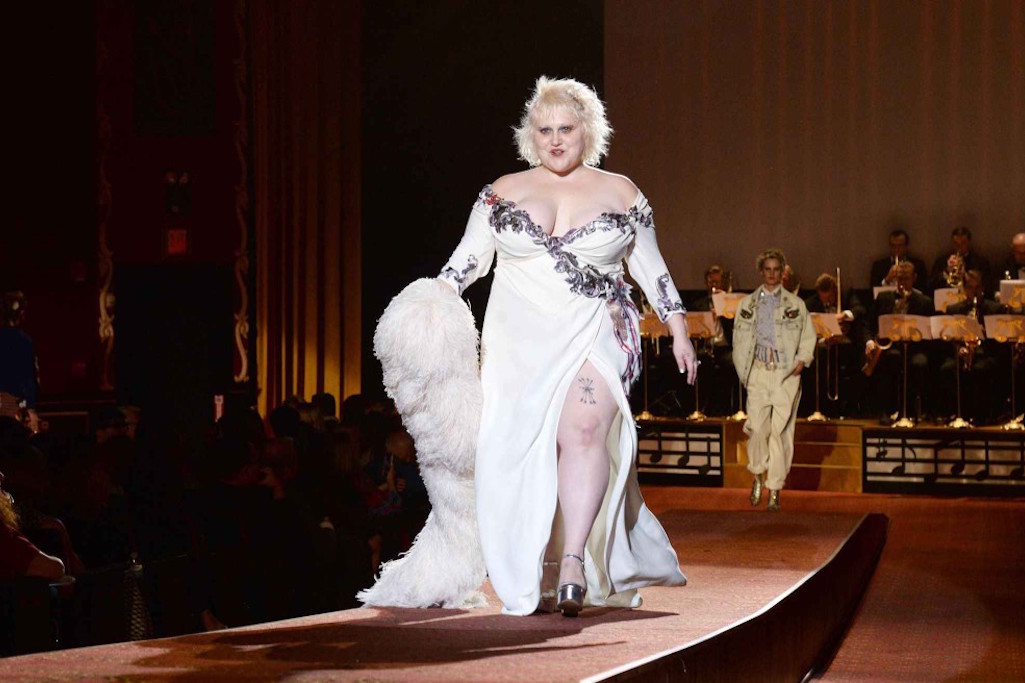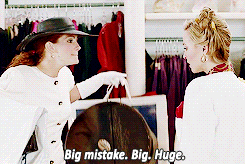Let’s Call Bullshit: You Can’t Flaunt Plus-Size Models Without Selling Plus-Size Clothes
Diversity is great! Diversity with clothes women could fit over their tits and thighs would be better.

I know that Fashion is not for me. I knew it as a chubby kid who cut out pictures of clothes from magazines and dreamt of being a designer. I knew it as a teen who sewed my own clothes and assured my friends that I was just really into bags and accessories on shopping trips, to disguise the fact that the clothes they were trying on were a far cry from the frumpy stuff a few aisles over that might fit me. And I knew it as a fat adult editor, clutching my camera at New York Fashion Weeks to shoot shows and designers, then write laborious and loving recaps of another new collection full of clothes that stood no chance of fitting over my thighs or tits.
I know that “capital F” Fashion does not represent me and is literally not designed with me in mind. I don’t like it, but I accept that it’s the reality. What I can’t accept are the insincere efforts made by designers like Opening Ceremony or Marc Jacobs to include fat women on runways in a tokenistic level, but never go so far as to cater to us as consumers.
–
Diversity For Clicks, But Not Dollars
I almost wrote this exact same article a year ago. I searched my Facebook Messenger conversations this morning because I so clearly remember the same morning in September 2015 when I saw the image of Beth Ditto modelling an incredible gown in Marc Jacobs’ SS16 show in New York City.
The collection was inspired by the films of John Waters, and there is no one who fits the image of a modern-day Divine like The Gossip singer. While everyone seemed to be crowing at what a win for body inclusivity this was, I felt steam coming out of my ears. I wrote to a friend: “I am so mad at the idea that putting one token fat woman on a runway or in an ad every five years is somehow a heroic act!” It had literally been five years earlier that Beth was part of Jean Paul Gaultier’s spring 2011 ready-to-wear show during Paris Fashion Week.
It was around that time that blogger Nicolette Mason called out Marc Jacobs’ CEO Robert Duffy for promising, two years earlier, that the label would release a plus-size range. “Where is it? I want it,” she said in a Q&A video for Cosmopolitan. “I would be your customer and you know it. Big fan of Marc Jacobs. Make this happen for me.”
That video was uploaded in 2012, and now, four years later, a cursory Google search for “marc jacobs + plus size” still only delivers articles congratulating him for placing Beth Ditto among the ocean of tiny bodies on his runway last year. Nicolette, and shoppers like her, are still waiting for them to come good on their promise to accommodate shoppers like they do one famous woman every five years or so.
This isn’t a situation unique to Marc Jacobs. This week, I watched the Snapchat live coverage of Opening Ceremony’s SS17 show. The show itself was a riotous celebration of global unity. It paid tribute to the victims of 9/11 and encouraged attendees to register to vote in the upcoming US election upon leaving. Transgender actress Sarah McBride walked in the show — which was hosted by Portlandia’s Carrie Brownstein and Fred Armisen — alongside Aubrey Plaza, Natasha Lyonne, Alia Shawkat, Rowan Blanchard, Jessica Williams, Rashida Jones, Diane Guerrero, Aidy Bryant and Whoopi Goldberg.
“Only in America,” Whoopi Goldberg said, “can a girl like me be on a stage like this.” https://t.co/UjiL4UbWPM pic.twitter.com/fdoZoINpET
— NYT Fashion (@NYTFashion) September 12, 2016
It was those last two names on the list that got me most excited. Since hearing Aidy declare herself a “size bitch” on Lena Dunham’s podcast, Woman of the Hour, I bowed at the feet of this woman. She has a body like mine and refused to apologise for it in an industry that is predicated on the assumption that bodies like ours are undesirable or invaluable. Likewise, Whoopi has always been an icon and a fixture on my screen, and seeing her walk down the runway with her VBO (Visible Belly Outline; look it up, it’s a thing) showing through that black dress was breathtaking.
Almost immediately, I got the email. For the first time ever, the newsletter declared, I could pre-order the pieces in the Fall II collection that I’d just seen on the runway, and have them on my doorstep by October. And just like that, the match to my fury was reignited. That skirt Whoopi wore was available for me to buy, sure, but it only ran from a US 0 to a 4. (In Australia, that’s a size 4-8 range.)
It wasn’t the first time the label instilled this sense of curdled disappointment and disbelief in me. Back in March, OC’s blog announced a story called “THICK GIRL TIPS FROM TWO WOMEN WHO DGAF WHAT YOU THINK”. As Instagram legends Dounia Tazi and Minahil Mahmood offered tips for battling chafing, fetishistic dudes and online hate (all things I can relate to intimately), readers were instructed to “see more pics of both of the girls in MadeMe’s Spring/Summer 2016 collection”. Pieces in that collection were modelled on waify frames and ran from an XS to a M. Thick girls might not GAF what you think, and these labels made it super clear they don’t GAF about thick girls, aside from the clicks they might garner.
… to find this pic.twitter.com/LrPKfp2Dsz
— Brodie Lancaster (@brodielancaster) March 20, 2016
–
We Have Money! Let Us Give You The Money!
Opening Ceremony is my favourite brand. When I lived in New York I visited their multi-level store on Howard Street almost weekly, marvelling at the construction of those Rodarte dresses that looked like Van Gogh paintings, peering at Venessa Arizaga jewellery through glass cabinets, and just touching this one butter-soft dress by Ysterike.
I couldn’t believe the intricate carving on the heel of the Rodarte x Nicholas Kirkwood heels existed outside my imagination until I held a pair in my hands. I lined up for the OC sample sales and muscled through the crowds on Fashion’s Night Out to take in their event at the Ace Hotel. Opening Ceremony designers Carol Lim and Humberto Leon were my heroes because they surrounded themselves with other people whose work I adored, and they made fashion fun and playful and silly, never scary or intimidating or exclusive.
The things they made never made me feel bad about myself like that industry so often did. I loved the way the wool of their Muppets sweaters accommodated my body, and bought that same signature item in different designs the moment they were released. I bought one of Deerdana’s signature pop culture portrait t-shirts because it miraculously came in a size XL so I could wear it without Dolly Parton’s face smooshing out like Marge’s on The Simpsons in that episode where Homer desperately tries to win her back in a series of horrifying gestures.

#Fashion
I bought shoes and a tote from OC’s second collaboration with Chloe Sevigny, and still wear both today, despite the fact they’re starting to disintegrate from five years of overuse. I love shopping at Opening Ceremony, but these purchases are the exception, not the rule.
It’s starting to feel like these fashion shows are the opposite: non-thin bodies are used to give designers and brands brownie points for inclusivity and diversity in a landscape that is still very white and very, very thin. And while larger bodies might be increasing in visibility during Fashion Weeks, our viability as potential consumers is still ignored.
Despite the instant sell-out success of plus-size collaborations — like Gabi Gregg’s with Swimsuits For All, Nicolette Mason’s with ModCloth, Rachel Antonoff’s with Gwynnie Bee, Nadia Aboulhosn’s with BooHoo, and Beth Ditto’s with Evans — we remain a market that so many brands just wish would shut up and go away. A lot of labels will say that it’s a matter of resourcing and demand; producing a line of clothing requires a minimum production quota be met for each size to make the line financially viable, and since larger sizes are thought to be in less demand, investing in them is seen as inevitably leading to wasted time/materials/money.
Unfortunately for those excuse-makers, the numbers are against them. In a piece for The Washington Post this week Project Runway host and mentor Tim Gunn called out the fashion industry for neglecting to meet the needs of their prospective consumers who happen to wear plus-sizes. ModCloth, he said, “paid for a survey of 1,500 American women ages 18 to 44 and released its findings: … More than 80 percent said they’d spend more on clothing if they had more choices in their size, and nearly 90 percent said they would buy more if they had trendier options. According to the company, its plus-size shoppers place 20 percent more orders than its straight-size customers.”
Now it’s not just personal or anecdotal experience backing me up: it’s Tim Gunn’s trove of stats and facts telling designers to stop discounting the literal value of plus-size customers.
We’ve been told for decades that our bodies should be covered up and hidden; that the way we look should be temporary, so therefore no investment pieces are worth the expense if our assumed goal (ie weight loss) is met and we can finally shop a straight-size range. But some of us have been fat forever. Some of us will likely stay fat forever. Some of us are very happily fat and actively seeking out — then throwing money at — the handful of brands who dare to cut a larger pattern and dress a larger person outside the context of a highly visible Fashion Week event and in something other than a paisley smock with an asymmetrical hemline and nonsensical shoulder cutouts.
Just today, I ordered hundreds of dollars worth of pieces (plural) from Tuesday Bassen and Project Runway winner Ashley Nell Tipton’s newly debuted collections, which run to 3X and 5X, respectively. I could be the “Big! Huge!” shopping revenge scene in Pretty Woman — “I’ve got money to spend in here!” — if only the designers and brands I love so much would give me something big and huge to spend my money on.

–
Brodie Lancaster is a writer and editor from Melbourne. She edits Filmme Fatales, a zine about women and cinema, and has contributed to Rookie, Rolling Stone, Vulture andPitchfork. She is a senior editor at The Good Copy and a mediocre DJ.